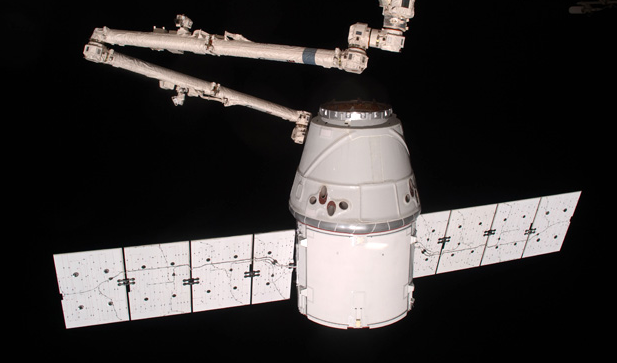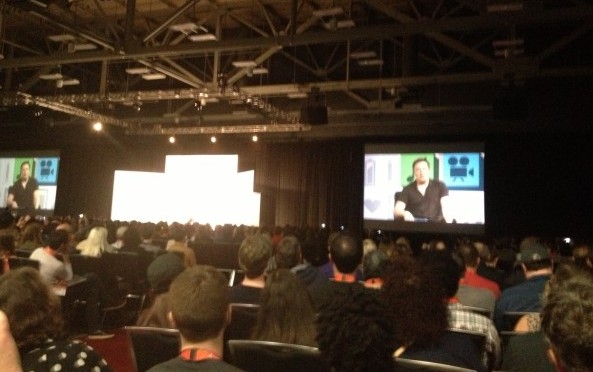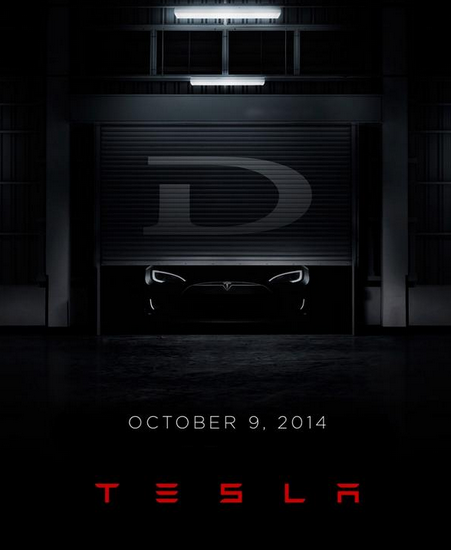[caption id="attachment_8353" align="aligncenter" width="617"]

SpaceX's Dragon vehicle just resupplied the International Space Station.[/caption] AUSTIN, TX—Elon Musk, CEO of SpaceX and Tesla Motors, took the keynote stage at this year’s SXSW to talk about everything from space exploration to electric cars. Joining him onstage to ask questions was Chris Anderson, the former
Wired editor and co-founder of 3DRobotics. Musk used his keynote discussion to show off a video of a rocket test, which he said had taken place earlier that week. In the video, a ten-story rocket takes off from a launching pad and hovers several hundred feet in the air before landing in the same spot, upright. It’s an early test of SpaceX’s reusable-rocket project. “Reusability is extremely important,” Musk told the audience. “If you think it’s important that humanity extends beyond Earth and becomes a multitenant species” then reusable rockets will prove essential. Every mode of transport we use on a regular basis is reusable, he added, from cars to airplanes: “If we can’t make rockets reusable, the cost is just prohibitive.” The cost of fueling a rocket is a mere fraction of building a new one. “Someone has to solve this problem,” he said. “So that’s what SpaceX has been trying to do, and really that’s been the goal since the beginning of the company, and so far I haven’t been successful.” If the reality matches the preliminary simulations, the company’s reusable-rocket design “should work.”
SpaceX
Musk’s fame and fortune stems from his founding of financial-services firm X.com, which eventually merged with Confinity, the company behind PayPal in late 1999. When eBay bought PayPal in 2002 for $1.5 billion, it made Musk very rich; from then on, he could pursue a life goal of tackling some of the world’s biggest problems, including clean energy and space exploration. With the latter goal in mind, he founded SpaceX in 2002. He headed to Russia and tried to buy some ICBMs; when that failed—for obvious reasons—his team resorted to its own designs. Six years later, the company scored a NASA contract for 12 cargo runs into orbit. On March 3, 2013, as Musk prepared to speak to SXSW, SpaceX’s Dragon cargo unit reached the International Space Station with 1,200 pounds of supplies onboard, overcoming a thruster glitch soon after its launch a few days before. “Nerve-racking” is how Musk described the experience of watching each SpaceX rocket taking off from the pad. As the vehicle arcs for the atmosphere, he always pictures the rocket crashing back down to Earth with the equivalent of a million pounds of TNT: “You’re going down in intensity as the rocket is going up.” The first three SpaceX launches failed, which resulted in what he terms “a powerfully engrained fear response” on his part. The initial stage of the most recent Dragon launch went well. SpaceX had time to work out the kinks in its systems, after all, and the vehicle was designed with a number of redundancies. Then the thruster problem cropped up. After securing some extra bandwidth from the Air Force’s telemetry dishes, the SpaceX crew built up the Dragon’s onboard pressure and used it to slam an offending valve open. “The spacecraft equivalent of the Heimlich maneuver,” Musk termed it. Musk wasn’t just in Texas for SXSW—he’s speaking with the state legislature about building a commercial launch site. “We need to be able to launch eastward, and we need to be close to the equator,” he said. Because rockets count as advanced weapons systems in the eyes of the U.S. government, it’d be difficult for Musk to export all of SpaceX’s technology to another country. “We need legislation passed that’s supportive,” he said. “One of the things we need, for example, is to close the beaches when we’re launching.” The ultimate goal, of course, is to get off the planet. The sun will expand and the oceans will boil in a couple hundred million years, destroying life on this little rock. This is the sort of thing that keeps Musk awake at night. “I would like to die on Mars,” he joked during the keynote. “Just not on impact.”
Tesla Motors
Tesla Motors is the result of Musk’s clean energy focus. The company produces electric cars such as the Tesla Roadster (a sports car), with an eye toward making that mode of vehicle more popular. In theory, enough purchases of higher-end vehicles will subsidize research that will lower electric-car costs into more mainstream territory. While Tesla has attracted a good deal of publicity over the years, the road hasn’t been entirely smooth. In February, for example, a public battle erupted between Musk and
New York Times reporter John Broder, who
claimed in a much-circulated column that his electric-powered Model S sedan had ground to a halt during a test drive up the East Coast. Broder suggested the luxury vehicle’s battery, adversely affected by the winter weather, had failed to last between the Tesla power-charging stations. Musk didn’t waste any time deeming the column a “fake.” In a lengthy corporate blog posting, he even questioned Broder’s integrity. “After a negative experience several years ago with Top Gear
, a popular automotive show, where they pretended that our car ran out of energy and had to be pushed back to the garage, we always carefully data log media drives,”
he wrote at the time. “While the vast majority of journalists are honest, some believe the facts shouldn’t get in the way of a salacious story.” Musk posted the data from Broder’s drive, which suggested the reporter had driven the vehicle at faster speeds than he claimed in the article (which would have drained the battery at a quicker rate), and that he had failed to fully charge the car at the available “supercharger” stations. After a few more blog postings and articles from both sides, each defending their respective positions, Musk seemed to let the whole thing drop. He didn’t even mention the controversy
during a Feb. 21 appearance on Jimmy Kimmel’s late-night show. But during his SXSW keynote, Musk appeared defiant about the whole incident. “I have no problem with negative feedback,” he told Anderson, in response to the latter’s question. “There have been hundreds of negative articles, and yet I’ve only spoken out a few times. I don’t have a problem with critical reviews, I have a problem with false reviews.” Besides, he evidently has larger things to worry about. [caption id="attachment_8354" align="aligncenter" width="593"]

Musk speaks at SXSW.[/caption]
Image 1: SpaceX  SpaceX's Dragon vehicle just resupplied the International Space Station.[/caption] AUSTIN, TX—Elon Musk, CEO of SpaceX and Tesla Motors, took the keynote stage at this year’s SXSW to talk about everything from space exploration to electric cars. Joining him onstage to ask questions was Chris Anderson, the former Wired editor and co-founder of 3DRobotics. Musk used his keynote discussion to show off a video of a rocket test, which he said had taken place earlier that week. In the video, a ten-story rocket takes off from a launching pad and hovers several hundred feet in the air before landing in the same spot, upright. It’s an early test of SpaceX’s reusable-rocket project. “Reusability is extremely important,” Musk told the audience. “If you think it’s important that humanity extends beyond Earth and becomes a multitenant species” then reusable rockets will prove essential. Every mode of transport we use on a regular basis is reusable, he added, from cars to airplanes: “If we can’t make rockets reusable, the cost is just prohibitive.” The cost of fueling a rocket is a mere fraction of building a new one. “Someone has to solve this problem,” he said. “So that’s what SpaceX has been trying to do, and really that’s been the goal since the beginning of the company, and so far I haven’t been successful.” If the reality matches the preliminary simulations, the company’s reusable-rocket design “should work.”
SpaceX's Dragon vehicle just resupplied the International Space Station.[/caption] AUSTIN, TX—Elon Musk, CEO of SpaceX and Tesla Motors, took the keynote stage at this year’s SXSW to talk about everything from space exploration to electric cars. Joining him onstage to ask questions was Chris Anderson, the former Wired editor and co-founder of 3DRobotics. Musk used his keynote discussion to show off a video of a rocket test, which he said had taken place earlier that week. In the video, a ten-story rocket takes off from a launching pad and hovers several hundred feet in the air before landing in the same spot, upright. It’s an early test of SpaceX’s reusable-rocket project. “Reusability is extremely important,” Musk told the audience. “If you think it’s important that humanity extends beyond Earth and becomes a multitenant species” then reusable rockets will prove essential. Every mode of transport we use on a regular basis is reusable, he added, from cars to airplanes: “If we can’t make rockets reusable, the cost is just prohibitive.” The cost of fueling a rocket is a mere fraction of building a new one. “Someone has to solve this problem,” he said. “So that’s what SpaceX has been trying to do, and really that’s been the goal since the beginning of the company, and so far I haven’t been successful.” If the reality matches the preliminary simulations, the company’s reusable-rocket design “should work.”
 Musk speaks at SXSW.[/caption] Image 1: SpaceX
Musk speaks at SXSW.[/caption] Image 1: SpaceX 